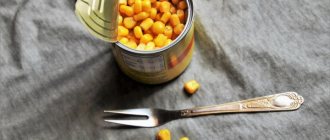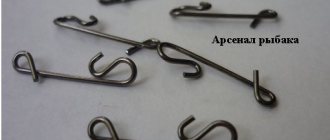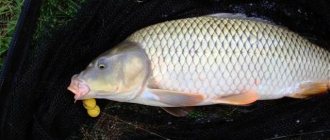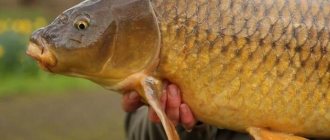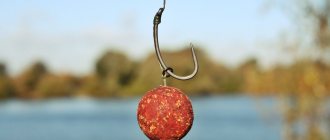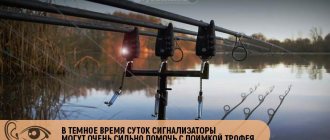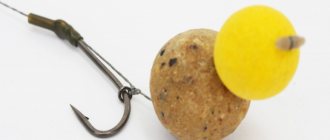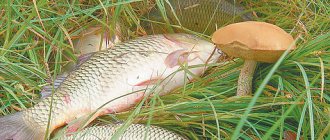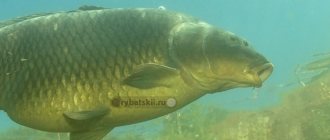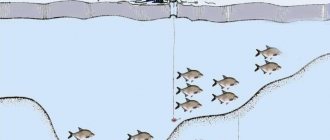Beginning fishermen mistakenly believe that the same techniques can be applied to carp as to its closest relative, carp. Indeed, the latter species is extremely popular, due, among other things, to its calm disposition. Therefore, there are many effective methods for catching this fish. However, the carp is distinguished by its restless character, quick reactions and large size. Although this is a species of carp, it is of wild origin. This fish usually lives either in river conditions or in ponds not associated with artificial farms. Accordingly, for productive fishing, you should take into account the secrets of catching carp, the rules for making and using gear, bait recipes and other subtleties of the process.
Optimal place for fishing
Carp is also a sedentary fish that does not like to change its place of life often. There are both pros and cons to this. On the one hand, you can count on periodic “work” in some places, but on the other hand, during the search process, the likelihood of accidentally discovering a fish habitat is reduced. A universal approach to identifying the right places is to focus on secluded and wild areas. At the same time, successful catching of carp on a bottom from the shore does not mean at all that the fish is hiding in shallow water, and this technique will be just as effective along the entire coast. With a greater degree of probability, the bite is due to the presence of a hole or a place under a snag at the casting point.
Especially in rivers, the carp looks for calm places where the current is not so active. These can be places of bends along the riverbeds, rubble and stone passages. Fish are also found on the edges, which are adjacent to zebra mussels, as well as in river bays with thick algae. The carp feeds closer to dawn - this is a very good time for the fisherman to become more active, but for this it is worth choosing the appropriate gear that is suitable for the season. The most favorable time for catching carp is in June, when it hides at the edge of the reeds or in thickets of the same algae. You should focus on arrowhead, water lilies, pondweed and water buckwheat. As for the depth, it should be at least 2-3 m. That is, it is clear that fishing near the shore can only be done at points of sharp decline along the holes. True, carp are also found in shallow water - just at that very time of dawn or dusk.
Time of year and day
Donka for carp works productively only in the warm period of the year, when the fish actively feeds and moves intensively around the reservoir. The activity of carp flocks begins to appear as the water warms up, towards the end of May and increases until mid-August. From mid-August, with the arrival of cold mornings, the fish become more passive and move to deeper areas of the waters. From this time on, you need to look for carp at the depths, where it will continue to feed periodically until the end of September, after which it will go to winter and fall into torpor until spring. In May and June, carp begin to feed at dawn, taking a break during the day and resuming their bite with the onset of evening. In hot July and August weather, the fish switches to feeding at night. In autumn, the bite lasts throughout the daylight hours.
Important! Carp does not like rain and low pressure, which depresses fish. Any cold snap has a negative impact on the bite. Stable sunny and warm weather favors biting, regardless of the fishing season.
River fishing gear
You could say these are classic fishing conditions. Most often, a regular fishing rod is used, in handling of which one negative factor should be taken into account - the current. Therefore, if possible, it is worth using a feeder. The river version of this gear has several differences from the traditional lake version. Firstly, the length of the rod varies on average from 3.5 to 4 m. Secondly, the weight of the tackle must cope with a large load. Even the average fish of this species is of considerable size, and if you take into account its behavior, the safety margin must be serious. If you initially plan to catch large carp, then the gear should be ready for a load of 100 kg. Means of combating the current are also provided. To do this, pay attention to the fishing line, which is best represented by a braided cord with a smaller diameter than similar monofilament options. Minimizing the influence of the flow will reduce the harmful effects on the equipment, but at the same time will not negatively affect the breaking force.
There is one more feature of such gear, which comes down to the mass of the feeders. When using such additions, you should focus on modifications whose weight is at least 120 g. In very turbulent river conditions, additional fastenings can be used - for example, experienced craftsmen fix wire tendrils to the lower part. If fishing with a donk with a feeder does not provide sufficient sensitivity, then it makes sense to switch to loop rigging schemes. The use of a paternoster, as well as symmetrical and asymmetrical loops, is practiced.
How to assemble a donk
Donka has significant advantages that make it the best choice for carp fishing:
- it allows you to make long casts, if necessary sending the equipment 100-150 m from the shore;
- during the current, the bottom equipment lies on the bottom and can remain at one point for as long as desired;
- When fishing with a bottom for carp with a feeder, the hook with bait is in close proximity to the bait, as a result, the likelihood that the fish will find it is maximum.
When fishing with a donk, you don’t have to constantly monitor the gear; you can install an audible alarm on it and just stay nearby. This is very convenient in carp fishing, because bites can occur quite infrequently - once every few hours.
To catch carp and carp you can use:
- Donku-zakidushka - in its simplest form, such tackle consists of a reel and a fishing line, at the end of which a sinker and a leash with hooks are attached, but you can attach the fishing line class="fa fa-external-link"> to a rod with a reel class="fa fa -external-link">;
- rubber band - the equipment of such a donkey includes a long piece of rubber, the advantage of the equipment is that you can silently place the bait at the same point over and over again;
- feeder class="fa fa-external-link"> - the most universal of sports bottom gear, which consists of a rod, a spinning reel and a fishing line with a feeder and a hook;
- carp fishing tackle is a powerful rod for bottom fishing with a spinning reel, designed specifically for carp fishing.
Rod
For carp fishing, a feeder class="fa fa-external-link"> or a special carp fishing rod with a length of 3.2 to 4.5 m is well suited. The test range suitable for such fishing is from 60 to 140 g. If fishing takes place in the river class=”fa fa-external-link”> in a good current, and this is where large carp often hang, you may need tackle with a weight of up to 150 g. Such a fishing rod should have a plug-in design.
Telescopic rods are not rigid and strong enough.
Coil
For carp fishing, mainly powerful spinning reels are used. If we are talking about small fish, a size of 2500-3000 will be enough. But catching good trophy carp involves using a spinning bait with a size of 5000 or more.
An intermediate option - models from 3000 to 4000 - are universal, they are well suited for catching both carp and other fish on the bottom. It is better if the reel is equipped with a baitrunner, then fishing will be more comfortable.
Multipliers, which due to their high power and excellent traction characteristics are also excellent for carp fishing, are rarely used, since there are no rods suitable for carp fishing designed for fishing with them.
The main line can be monofilament, braid or fluorocarbon. Monofilament is most often used for carp fishing.
Thanks to its high stretchability, it perfectly absorbs the jerks of the fish, helping with fishing. The advantage of braid is that it provides long casts and the highest sensitivity of the gear.
But catching fish with it is much more difficult. Fluorocarbon occupies an intermediate position between monofilament and braid in terms of stretchability.
Reference! For catching carp weighing up to 10 kg, a monofilament with a thickness of 0.3 mm is enough. If larger fish are expected in the catches, you can use larger diameters - 0.35 or 0.4 mm.
Sinker and feeder
To catch carp and carp on a bottom fishing rod you can use:
- sinker;
- standard feeder;
- spring feeder (type method).
Sinkers are often used when fishing for carp and carp using boilies class="fa fa-external-link">. If the usual bait is not used, then the feeder becomes useless. Bait boilies are thrown into the water separately from the equipment.
If regular bait is still needed, it is worth placing a standard feeder feeder on the tackle. For river fishing, you need rectangular-shaped models that will not be dragged along the bottom by the current. In standing water, the shape is not particularly important; round feeders can also be used.
But instead of a standard feeder, you can use a method feeder. Its advantage is that you can place the nozzle directly into the bait hammered into the spring. Thus, the fish is guaranteed to find and swallow it sooner or later.
Leashes and hooks
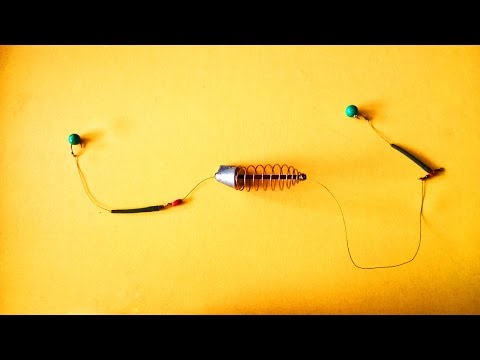
To make leashes for donkeys for carp you can use:
- monofilament;
- fluorocarbon;
- braid;
- special leader material for carp fishing.
The size of the hooks must be selected first of all for the bait, and only then for the expected size of the trophies. The most commonly used hooks are class="fa fa-external-link"> 6, 8 and 10 numbers according to the international classification.
Attention! For fishing in places where there is a lot of grass, models with a concave tip, which will cling less, are better suited.
Bite alarms
The role of a signaling device when fishing for carp and carp can be performed by:
- bell;
- feeder tip (quivertip);
- electronic sound signaling device.
Any of these options will do. The quivertype has a significant drawback - in order not to miss a bite, you must constantly keep it in sight.
For carp fishing, this option is not very convenient, since large fish bite quite rarely. Sometimes you have to wait several hours until the fish becomes interested in the bait.
Therefore, when fishing for carp, many people put a class="fa fa-external-link"> and a bell on the feeder.
Before you go to an unfamiliar body of water, you should definitely make inquiries about it.
If possible, you should talk to local fishermen - for example, these could be salespeople in stores - to learn from them the nuances of fishing on a particular pond, lake or river.
To achieve the best catches, it is better to use not 1, but 2, 3, or 4 donks at once. When the number of gear thrown into the water increases, the likelihood that the fish will quickly find a hook with bait increases significantly.
For those who have already caught other fish on the bottom - for example, the same crucian carp - carp fishing will not create much difficulty. Although, of course, catching such large and strong fish requires a special approach.
And here's what you need to know: How to choose a spinning reel
All gear must be strong, all knots must be tied carefully and without unnecessary haste. The donkey for carp and carp should be reliable, in which case you won’t have to worry that it might fail at the most inopportune moment - while fighting with large fish.
Simple and catchy tackle for carp, carp, crucian carp.
You should look for carp where there is a muddy bottom and there are thickets of reeds or algae. Experienced fishermen pay great attention to luring prey, using various baits.
Having decided on the place where the fishing process itself will take place, it is necessary to prepare bait. In the meantime, it gets wet, you need to collect the gear and after about 15 minutes you can throw in the first bait, which is previously placed in the feeder. After casting, the rod must be secured.
The small fish appear first, but the larger prey will follow. During the entire process, it is necessary to monitor any changes in the bite, without leaving the rod unattended. If small fish start to be caught again, you need to add nutritious food.
After the carp grabs the bait, there is no need to make unnecessary movements, since it hooks itself. You should behave calmly and confidently, as the carp will resist to the last. If the fish has gone under a snag, then there is no need to try to pull it out. You need to secure the fishing rod and wait a little. After some time, the prey will come out on its own.
Carp is a cautious fish, so you should not talk loudly when fishing for it. In open places, it is recommended to camouflage yourself using dry brushwood or reeds.
In summer, carp are easy to find by their characteristic splashes. It can be attached to a place chosen by the fisherman. To do this, it is necessary to throw vegetable bait above the main fish site at the same time.
If fishing will take place from a boat, then it is better to use a float rod, spinning rod or winter fishing rod. In reservoirs with shallow depths, a leash or float tackle is suitable.
On rivers with a flow of catches, a feeder fishing rod is most often found. If the current is strong, then the load must be heavy.
On small ponds, bays and lakes, experienced fishermen use float rods, weighted bottoms or bottoms with an elastic band. In strong winds, it is better to catch prey using feeder or trolling gear.
The choice of gear for catching carp is quite large, and each fisherman chooses the most convenient one for him. But, since carp is a large, strong fish, all equipment must be sufficiently powerful and durable.
Tackle for fishing in water conditions
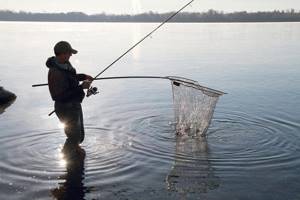
Quiet water bodies are recommended for inexperienced fishermen to get acquainted with carp. You should start by using fly fishing rods. It should be noted right away that the calmness of the water surface does not guarantee ease in the fishing process. All methods of catching carp using float tackle involve the risk of colliding with underwater obstacles in the form of bushes, snags, algae, fallen trees, etc. In quiet ponds and reservoirs there are no fewer problem areas than in the river - and these are the areas the carp chooses for its habitat.
Actually, one thing is required of the fisherman at the preparation stage - to choose a strong fishing rod about 5 m long. Assembling the structure taking into account the feed is also important. For example, when fishing for carp on corn, the installation of gear for which requires the connection of feeders, one must calculate a way to insure it against fluctuations in current conditions. That is, the rod must also cope with the weight of the sinker.
If you plan to work with long casts, then you should prefer mast tackle. The length will be the same, about 4-5 m, but the very technique of handling this fishing rod will make the fisherman’s task easier. But there is also an important point in choosing a reel - it must be an inertia-free mechanism of at least 3500 in size, equipped with a friction brake. On site, it is also important to correctly load the match float so that it is sensitive and does not get lost from sight over long distances. On the question of how to catch carp in calm conditions, you can turn to plug fishing rods. Such models are designed specifically for strong and large fish, which are helped by the presence of a rubber shock absorber.
Bottom rig configurations
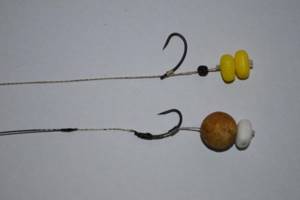
For the basic version of such equipment, you will need a feeder, monofilament, a hook with a swivel, as well as high-strength fluorcarbon fishing line. First of all, take a monofilament line about 50 cm long, after which this segment is folded in half, but so that one end is about 10 cm longer than the other. Next, a swivel is attached, on which the feeder will later stand. After this you can tie a knot. Then a fluorcarbon fishing line 1 m long is taken. Using the “loop-to-loop” technique, the leash is fixed to the long end and attached to the tackle with the feeder. Depending on the weight of catching carp on the bottom from the shore, you can vary the parameters of the loops.
Variations of equipment that are used by amateur fishermen have also become widespread. For example, one of the simplest options of this type is called a “nipple” and operates on the principle of a spring. For assembly you will need a spiral feeder or a plastic bottle cap (future spring base), several hooks (from 1 to 4) and a braided fishing line for leashes. A spring feeder is fixed to the main fishing line, on which a bead stopper is placed. Then it is necessary to make leashes from wicker material, which will be fixed around the circumference of the spring with equal indentations. Finally, bait is attached to the hooks. If catching carp on a bottom from the shore does not give the expected result, then the efficiency of the process can be increased in several ways. For example, a pheromone additive can be used as a bite activator, which is equally suitable for both cold and warm water environments.
Creating optimal conditions and choosing weather
Carp is not against eating bait of various origins, depending on the temperature and season:
- Potatoes are the most popular bait. However, the tubers must be selected in such a way that they remain quite strong during the cooking process. It is best not to peel it in water without adding salt.
- Millet. To begin with, you just need to boil the millet porridge, and once ready, carefully turn it into a homogeneous mixture. Next, the millet should be steamed in the oven. The resulting “casserole” is cut into pieces in proportion to the size of the hooks.
- Corn. Most of all, carp loves young grains of medium hardness. If you use the uncanned version, you must cook it in water without salt.
- Berries. Surprisingly, the carp turns out to have a sweet tooth and is not averse to profiting from ripe blackberries, currants, grapes, raspberries or plums.
Also worth noting are worms. The future catch depends on their size. The more, the heavier the kilograms will be. It’s also a good idea to use maggots.
Choosing a fishing line for carp
Any responsible fisherman, before mastering new methods of catching unfamiliar fish, will certainly read the relevant literature and find out the experience of other colleagues. In the case of carp, the first thing you can hear is its incredible strength, which only strong equipment can help to tame. As a result, many try to make components as strong, thick and powerful as possible. This rule is quite suitable for a fishing rod or spinning rod, but the choice of fishing line is not so clear. It is believed that reliable, from the point of view of preventing breaks, catching carp on a bottom from the shore is carried out using monofilament lines with a diameter of about 0.25-0.3 mm. But, as practice shows, there is no need for excessive insurance in this matter, since the shock leader takes on the main burden. Its length of 12 m will ensure resistance to both the underwater edge and notches in snags.
On the other hand, the advisability of using thick fishing line as a safety net is also not rejected by some even experienced fishermen. But this aspect is also controversial. A thick fishing line, with all its strength, will create the effect of a sail under water, which will adversely affect the behavior of the sinker. Therefore, donka fishing with a feeder can easily be done with a fishing line whose thickness is 0.2-0.25 mm.
How to feed carp
The carp is fed in advance, long before fishing. Experienced fishermen start baiting a few days before the day of fishing, this is how they achieve maximum catch. The bait should be partially or completely identical to the bait on the leash.
Thus, the optimal bait is a mixture of cereals, feed and cake. Basically, anything edible that you have on hand is suitable for bait. Special baits are also sold separately, but they are more expensive and are not always suitable for the fish in your pond.
Requirements for the sinker
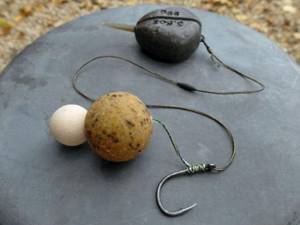
In the case of the choice of the functional part of the equipment, the same problem arises of the mutual dependence between the ability to withstand the load from the force of the fish, as well as the overall ergonomics and efficiency of the assembly. As with fishing line, many people want to strengthen the base by choosing a heavier sinker. Mid-category fishing rods are designed for weights of about 130 g. At the same time, do not forget about power, calculations for which will allow us to conclude that, for example, weighing the base to 400 g will make it impossible to use such equipment. And this is not to mention the fact that additional load will be provided by snags and other underwater obstacles, to which hooks for catching carp, operating on the principle of an anchor, often cling. Nevertheless, it is also necessary to resist the current. Professionals solve this problem not by increasing mass, but by using correctly selected forms. In strong currents, it is worth abandoning pear-shaped elements in favor of frame weights, the flat surface of which optimally holds the bottom.
What to fish with
There are a lot of options for the main bait, both animal and plant origin. According to statistics, the former are used less often than plant bait. This is due to the fact that worms with leeches, for example, in addition to carp, also attract pike and perch. And when predators approach, the carp rushes for cover. If the choice falls on this option, then it is better to use bunches of worms in the spring. The main means of providing this part should be legumes and corn. It is advisable to use the first option after thoroughly soaking it in salt water. There will be other nuances if you plan to catch carp using corn. Installing the tackle according to the classical principle with a fly or mast fishing rod provides the possibility of attaching several grains in such a way that the hook tip remains bare. You can use canned corn, or prepare it yourself by softening it in water over low heat.
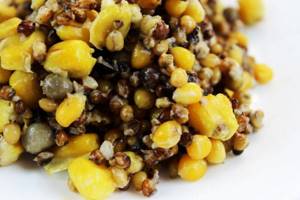
What should the bait be like?
Large peaceful fish eat cake, crackers, corn, peas and other products. But again, it is important to prepare the foundation correctly. Usually they form something similar to a vinaigrette or porridge. It is important to consider that carp in summer is not as picky as in spring. Therefore, there are practically no restrictions in bait recipes. But there is another problem, as is the case with animal bait. This is a risk that the bait will attract non-target fish, including silver bream, ide, sabrefish with bream, etc.
Therefore, it is still worth adhering to some rules of fish cooking, which allow you to precisely feed the carp. In river conditions, the optimal recipe would be the following: add 50 g of amino acids to a mixture of 4 kg of pellets and 1 kg of cut boilie. Next, the question arises of how to catch carp using the resulting pulp. Ordinary clay should be used as a binder, which can be collected directly at the fishing site near the river. The mixture is kneaded, after which balls are formed. They should be placed on the hook.
Lures for catching carp on a donk

When fishing for carp, different baits are used, both plant and animal. Corn, peas, cake, worms, maggots are readily eaten by this fish. Preference should be given to plant baits in places where small fish do not allow easy fishing with animals.
The most popular bait currently among experienced carp fishermen are boilies. Boyle is an artificial bait in the shape of a ball. It consists of compressed cereals and grains. egg powder and various additives that stimulate interest in this bait among fish.
Boilies are used not only as bait on a hook, but also as a bait mixture. Mixed with boiled corn, boilies are widely used both when fishing in still waters and in the current.
Recommendations for fishing techniques
Immediately after choosing a place and location, you should feed the fishing area and start preparing gear. There is no need to skimp on casting length. Especially in large reservoirs and ponds, the rule is that long casting ensures large fish. However, the first bite may disappoint with small fish - you should also prepare for this. And you can't relax. Although the fish is large, it is nimble, and reactions can be unexpected. Therefore, fishing for carp in June should be carried out with one tackle, otherwise there is a risk of simply not being able to keep up with all the fishing rods. There may be both breaks and periods of high activity in the process. If there is no reaction for a long time, then perhaps the bait has disappeared into the crack - it’s worth checking this and, if necessary, re-replacing it.
